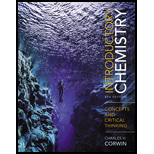
(a)
Interpretation:
The labeling of each atom in the polar covalent bond
Concept introduction:
Electronegativity is defined as the tendency of an atom to attract electrons towards it. Polarized bonds are a result of the electronegativity difference between bonding atoms. The more electronegative atom acquires a partial negative charge and the less electronegative atom acquires partial positive charge while showing charge distribution.
(b)
Interpretation:
The labeling of each atom in the polar covalent bond
Concept introduction:
Electronegativity is defined as the tendency of an atom to attract electrons towards it. Polarized bonds are a result of the electronegativity difference between bonding atoms. The more electronegative atom acquires a partial negative charge and the less electronegative atom acquires partial positive charge while showing charge distribution.
(c)
Interpretation:
The labeling of each atom in the polar covalent bond
Concept introduction:
Electronegativity is defined as the tendency of an atom to attract electrons towards it. Polarized bonds are a result of the electronegativity difference between bonding atoms. The more electronegative atom acquires a partial negative charge and the less electronegative atom acquires partial positive charge while showing charge distribution.
(d)
Interpretation:
The labeling of each atom in the polar covalent bond
Concept introduction:
Electronegativity is defined as the tendency of an atom to attract electrons towards it. Polarized bonds are a result of the electronegativity difference between bonding atoms. The more electronegative atom acquires a partial negative charge and the less electronegative atom acquires partial positive charge while showing charge distribution.
Want to see the full answer?
Check out a sample textbook solution
Chapter 12 Solutions
Introductory Chemistry: Concepts and Critical Thinking Plus MasteringChemistry with eText -- Access Card Package
- 18.) Choose all the statements that are correct. (1) Like atomic size, electronegativity decreases going across a period and increases going down a group. (2) The second most electronegative element is chlorine. (3) Electronegativity is directly proportional to atomic number. (4) Like ionization energy, electronegativity increases going across a period and decreases going down a group. (5) Electronegativity is a measure of the ability of an atom to attract electrons and form a negative ion. (6) Electronegativity is a measure of the ability of an atom in a molecule to attract electrons go itself. (7) Electronegativity was first proposed by Linus Pauling. Group of answer choices (2) (1) (4) (3) (5) (7) (6)arrow_forwardGive reasons which is correct. And give reasons why other options are incorrect. Note:- Hand written solutions are strictly prohibited.arrow_forwardShow how each chemical change obeys the octet rule. (a) Hydrogen forms H2 (hydride ion)arrow_forward
- Draw Lewis diagrams for the following ions. In the formula the symbol of the central atom is given first. (Hint:The valence octet may be expanded for the central atom.)(a) BrO4 - (b) PCl6 - (c) XeF6+arrow_forwardWrite a Lewis diagram for I-3, the linear (tri-iodide) ion.arrow_forwardWhich of the following statements are true regarding an ionic bond between cobalt and sulfur in a CoS formula unit? (a) Cobalt ions and sulfide ions bond by electrostatic attraction. (b) Cobalt atoms gain electrons and sulfur atoms lose electrons. (c) The ionic radius of a cobalt ion is greater than its atomic radius. (d) Breaking an ionic bond between cobalt and sulfur requires energy.arrow_forward
- 10arrow_forward3) The molecule diphosphorus tetraoxide (P,O,) has two central atoms and four different resonance structures that do not violate the octet rule. Draw two of these resonance structures below. 4) The compound acetone is a common solvent. It has a chemical formula of CH,COCH, Acetone has three central atoms. (a) Draw the Lewis Dot structure for acetone. (b) Give the Ideal Bond Angle for all three central atoms. 5) Four covalent molecules are drawn below. :o: H. H-CH H H (1) (2) (3) (4) a) Define each of these molecules as polar or non-polar. (1) (2) (3) b) Describe the type of intermolecular force that each molecule would use: (1) (2) (3) (4)arrow_forwardArrange the following elements in order of decreasing electronegativity. Rank from most to least electronegative. To rank items as equivalent, overlap them. Nitrogen, Phosphorus, Lithium, Nickelarrow_forward
- Which of the following statements are true regarding an ionic bond between calcium and oxygen in an CaO formula unit? (a) Calcium ions and oxide ions bond by covalent attraction. (b) Calcium atoms lose electrons and oxygen atoms gain electrons. (c) The ionic radius of a calcium ion is less than its atomic radius. (d) Breaking an ionic bond between calcium and oxygen releases energy.arrow_forwardQuestion 16: Answer Letter A ONLY Question 24: Answer Letter C ONLYarrow_forwardDraw the most important Lewis structure for [ IF4 ]+ (assuming it exists) and then answer the following questions. The underlined atom is the central atom. All other atoms are bonded directly to the central atom. (a) What is the electron-group geometry, according to VSEPR theory? (b) What is the molecular geometry? (c) Is this species polar or nonpolar?arrow_forward
 Introduction to General, Organic and BiochemistryChemistryISBN:9781285869759Author:Frederick A. Bettelheim, William H. Brown, Mary K. Campbell, Shawn O. Farrell, Omar TorresPublisher:Cengage Learning
Introduction to General, Organic and BiochemistryChemistryISBN:9781285869759Author:Frederick A. Bettelheim, William H. Brown, Mary K. Campbell, Shawn O. Farrell, Omar TorresPublisher:Cengage Learning
